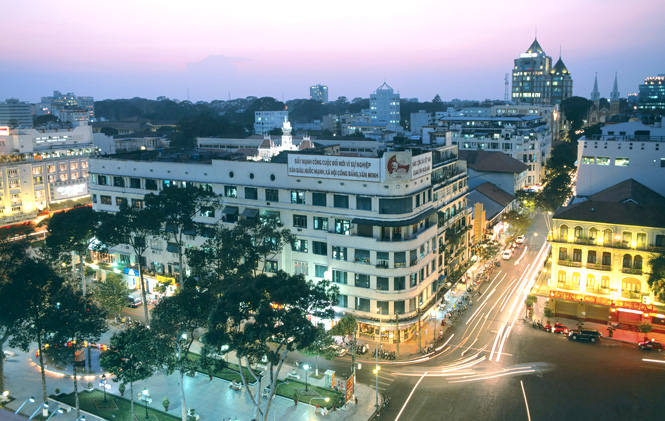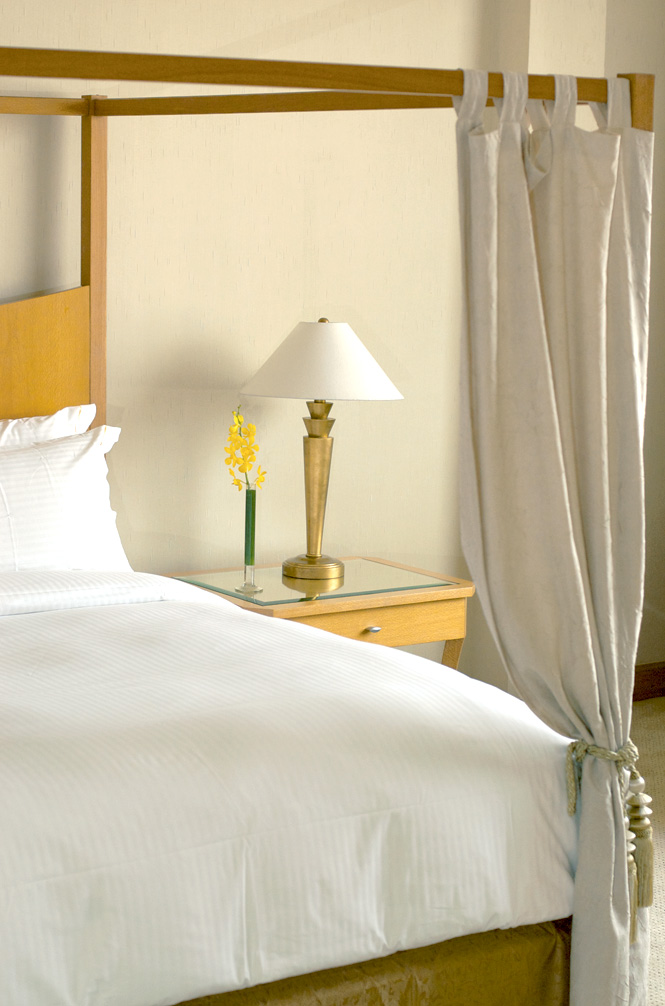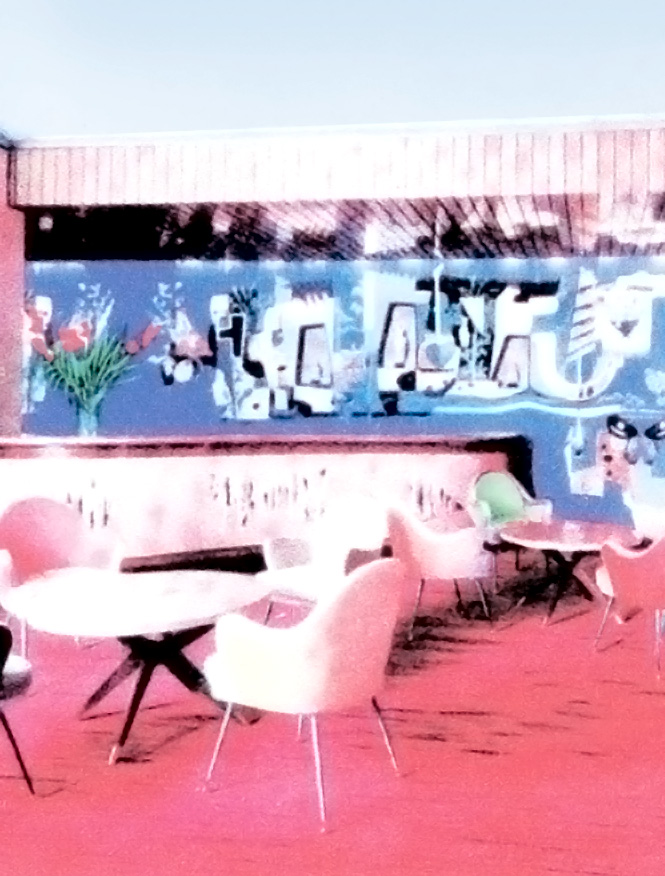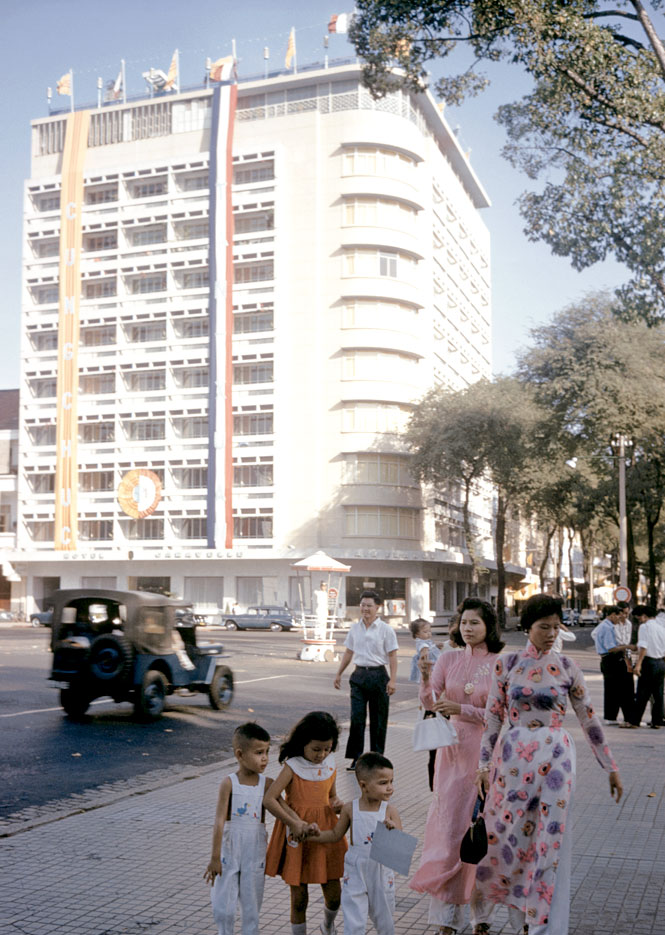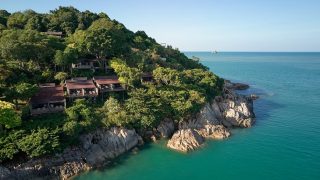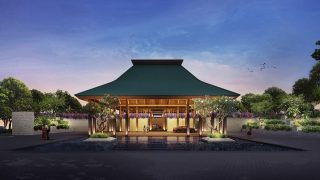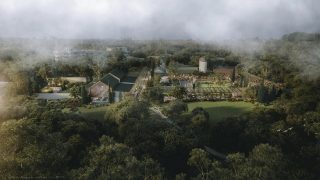Above: The Caravelle’s lobby lounge looks out on the French-colonial Municipal Theater.
With 50-plus years of eventful history, what stories they would tell if the walls of the Caravelle Hotel could talk
By Christopher R. Cox
While there are now far taller buildings in booming District 1, no hotel casts a longer shadow across Ho Chi Minh City than the Caravelle, which has mixed history and hospitality for 50 eventful years. Now an address of choice for businesspeople and dignitaries, the Caravelle once served the world’s press corps, who chronicled the war in Indochina from here in thousands of dispatches bearing a SAIGON dateline. The walls of the hotel may not be able to talk, but veteran newsmen will vouch for its bona fides in the annals of 20th-century journalism.
“On every big story I have covered these past 50 years,” recalls journalist Peter Arnett, “there has always been a favorite press corps hotel, from the Constellation in Vientiane in the late 1950s, to the Caravelle or the Continental in Saigon … to the Al Rashid in Baghdad in the first Gulf War to the Palestine in the second. These places became our homes through shelling and sieges, and where we bonded or broke up.”
Even as the French defeat at Dien Bien Phu in 1954 signaled the end of colonial Indochine, a pair of Gallic entrepreneurs acquired a lot at the corner of Saigon’s Rue Catinat and Theatre (now Lam Son) Square. On this prestigious intersection, they commissioned Vietnamese architect Nguyen Van Hoa to design a superlative structure: the tallest, toniest, most contemporary building in the new Republic of Vietnam.
With a gracefully curved, balconied corner, the nine-story hotel boasted all the mod cons: hot and cold running water, electricity, a backup generator, bullet-proof glass, and air-conditioning to combat the city’s enervating heat and humidity. The crowning touch was a rooftop terrace, anchored by the Champs-Élysées restaurant, which offered the grandest panoramas of Saigon.
The gleaming landmark with an illuminated sailing-ship logo debuted on Christmas Eve 1959. Its A-list tenants included coinvestors Air France (whose newly acquired fleet of Sud Aviation Caravelle jetliners gave the hotel its name) and the Australian Embassy. As the war between North and South Vietnam expanded, news organizations such as CBS News and ABC News set up their offices at the hotel, which stood out, according to one writer, “like an American in Hong Kong.”
“The Caravelle was the most modern hotel in Saigon, with elevators that worked and good room service,” relates Arnett, who first arrived in 1962. “The TV networks all stayed there, guaranteeing that food and booze service was well maintained. It was also located in the dead center of town and a place of rendezvous for the most interesting U.S. and foreign diplomats and military people.”
Saigon’s other storied “war hotel,” the Continental Palace, stood directly across the square. Considered much more of a residential accommodation, it attracted the likes of Graham Greene, who set much of his prescient novel, The Quiet American, at its famed terrace bar, known as the Continental Shelf. But if the Continental had more soul, the Caravelle countered with state-of-the-art technology, meat-locker-cold air-conditioning, and the best late-night bar in town, the Jerome and Juliette.
In addition to Arnett, it attracted some of the most recognizable bylines of late-20th-century journalism, including Walter Cronkite, David Halberstam, and Malcolm Browne. Other American luminaries bedded down here too, such as comedian Bob Hope, director John Ford, Nobel Prize–winning author John Steinbeck, and, during his so-called wilderness years, Richard Nixon, who stayed in 1964.
For reporters in particular, the rooftop terrace offered an unbeatable combination of expert cocktails and a front-row seat to the war.
“On the roof of the Caravelle … I watched helicopter gunships and bombers attacking suspected Vietcong concentrations on the city’s outskirts and saw fires blossom on the docks downriver,” Cronkite wrote in his memoirs. And in his acclaimed Dispatches, Michael Herr, who covered the war for Esquire magazine, recounts “having drinks and watch[ing] the air strikes … so close that a good telephoto lens would pick up the markings on the planes. There were dozens of us up there, like aristocrats viewing Borodino from the heights.”
Foreign journalists weren’t the only ones to frequent the hotel. In 1960, the Caravelle became the haunt of a group of Saigon intellectuals frustrated with President Ngo Dinh Diem’s autocratic and nepotistic regime. Dubbed the “Caravellists” because of their frequent meetings here, they drew up a manifesto calling for reform. Many were subsequently arrested, but their disaffection soon spread to the South Vietnamese army and climaxed with the U.S.-endorsed coup of 1963, during which Diem and his notorious younger brother and chief adviser, Ngo Dinh Nhu, were executed.
The war literally hit home on August 25, 1964, when a bomb exploded in Room 514, dealing structural damage to three floors. But the Caravelle sailed on, providing top-notch standards and every possible amenity—including the salacious “special massage” at its health club.
“The staff at the hotel was extremely efficient,” says veteran newsman Robert Wiener, author of Live from Baghdad, who worked for both ABC News and NBC News in Vietnam. “They kept the place spotless.” When South Vietnam fell in April 1975, Wiener, Arnett, and a group of other reporters watched the collapse from the best seat in town.
“The night of the 29th, the roof was packed with press watching the North Vietnamese bombard the airport,” Wiener relates. “It was clear the war would end … one way or another within hours, which it did.” He adds, “Unlike many reporters, who fled in panic, I made a point of paying my bill in full before checking out. But the front-desk people were also frightened and flustered and I failed to get a receipt.”
With the Communist victory, the guest profile changed dramatically. Gone were the TV journalists and their generous expense accounts. In their stead were dour Muscovites from the Russian embassy. The Caravelle—rebranded as the government-owned Doc Lap (Independence) Hotel from 1975 to 1998—sank into a malaise until the early 1990s, when the economic reforms of doi moi gained traction.
In 1992, the state-run travel service Saigon Tourist entered a joint venture to resurrect the faded property. Ground was broken on a new 24-story, 260-room wing—emblematic of Vietnam’s rapid economic development—that opened in 1998. The original building was gutted and entirely renovated from 135 to 75 larger rooms, though the elegant exterior lines survived. The rooftop terrace, renamed Saigon Saigon Bar, now rocks to the funk of a Cuban salsa band. More than any of its prewar predecessors, such as the Continental and the Rex, the Caravelle has segued nicely into the 21st century.
Other downtown high-rises block some of the vistas, but the view up Rue Catinat (now Dong Khoi Street) to Notre Dame Cathedral remains superb. Halfway to its twin spires, bar-goers with a sense of history can spot the rooftop of the former Pittman Apartment building —scene of Hubert Van Es’s iconic photograph of the last American helicopter evacuating Saigon.
Wiener, along with Arnett, plans to return this May to take part in the Caravelle’s 50th-anniversary festivities. He also intends to clear up some decades-old paperwork.
“I think I’ll ask for [that 1975 receipt] and submit it to NBC News,” Wiener says. “The bean counters there are still sticklers.”
19 Lam Son Square, District 1, Ho Chi Minh City; 84-8/3823-4999
Originally appeared in the May 2009 print issue of DestinAsian magazine (“Landmark: War and Peace”)


